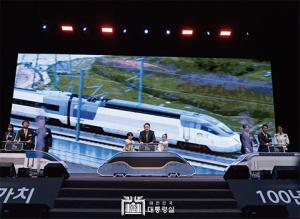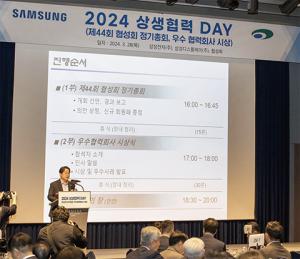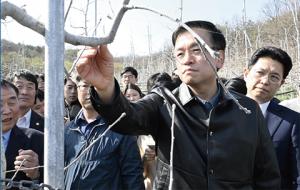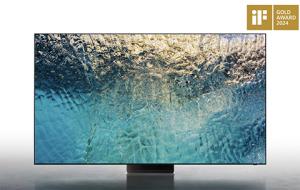?
내가 그린 그림은... 글 그림이며
문자도의 맥을 잇는 젊은 동양화가 봉은영
Paintings I Drew... are Paintings of Letters
Young Asian painter Eun-yeong Bong embracing traditional Munjado painting
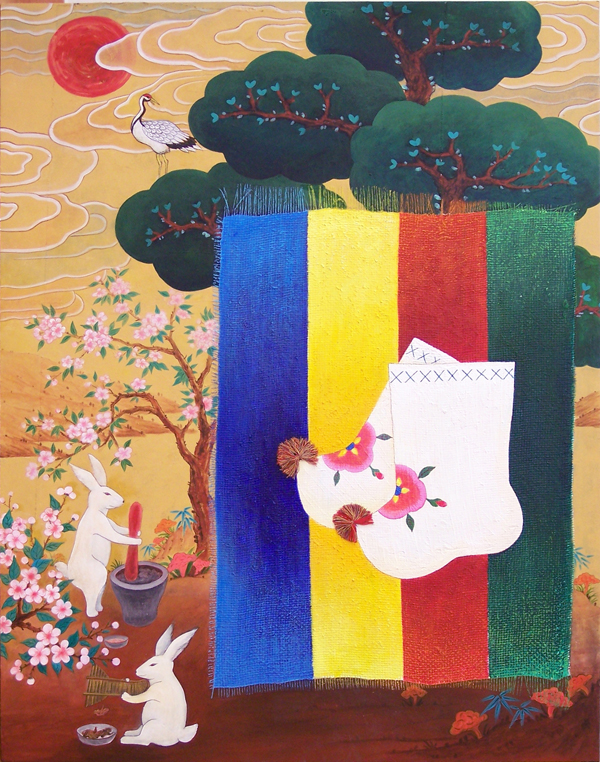
한문은 문자 그대로 한민족의 글자로서 지금으로부터 약 5,000여 년 전에 한민족에 의해 만들어 졌다고 전해진다. 중국 고대의 황제가 다스리던 시기에 사관이었던 창힐이 새 발자국을 보고 만들었다고도 하고, 사슴 발자국을 본떠서 만들었다는 설도 있다. 혹은 복희씨가 팔괘를 그어서 만들었다는 전설도 있다. 여하튼 다른 고대 문자의 기원이 그러하듯이, 한자도 그림에서 출발했다는 점은 부인할 수 없는 역사적 사실이다.
그렇다. 한자는 그림이다. 사물의 모양을 본떠서 만든 상형문자로서 글자의 모양만 보아도 그 뜻을 미루어 짐작할 수 있게 만들었다. 그림 역시 굳이 말을 들어 설명하지 않더라도 그 뜻을 알 수 있다는 점에서 한자와 그림은 서로 맞닿아 있다. 이에 착안하여 한문을 도안한 그림을 흔히 문자도(文字圖)라고 한다.
작은 글 그림이 품은 큰 뜻 
본래 문자도란 민화의 한 종류로서 한자와 그 의미를 형상화한 그림을 일컫는 말이다. 주로 고사성어 등의 내용을 자획 속에 그려 넣어 서체를 구성하는 그림으로 크게 목숨 수(壽)와 복 복(福)자를 도식화한 수복도와 사람으로서 마땅히 갖추어야 할 네 가지 덕목을 뜻하는 효제충신(孝悌忠信)과 입을 것과 먹을 것이 풍족해야 예절을 안다는 예의염치(禮義廉恥)를 도식화한 효제도로 나뉜다.
이러한 문자도를 그리는 화가 가운데 최근 주목을 받는 젊은 작가가 동양화가 봉은영이다. 한자를 전통적인 도안과 현대적인 색감, 기법을 접목시켜 표현하고 있다는 평을 받는 그는 길상 문자인 복(福)을 주로 소재로 삼는다. 현대인 모두가 바라는 행복. 이 문자를 통해 감성적인 공감대를 형성하고 우리네 솔직한 삶의 정서와 자유분방한 아름다움을 표현해 보고자 했다는 것이다. 어려운 현실을 극복하고자 하는 소망, 보는 이가 좋은 기운을 얻을 수 있었으면 좋겠다는 뜻도 담았다.
전통과 현대의 어울림, 글과 그림의 조화
지난 2011년 8월, 서울무역전시 컨벤션센터에서 열렸던 KASF(Korea Art Summer Festival) 2011에서 첫 개인전을 열면서는 전시회의 이름을 원+망 전(願+望 展)이라 불렀다. 영어로는 want와 hope로서 동일 제목이다. 좋은 복을 바라는 현대인의 마음을 담았던 전시회였다.
전시회에 소개된 봉 작가의 문자도 연작에는 전반적으로 우리네 정서와 문화가 많이 묻어난다. 한중일의 문화인 한자를 주요 화두로 삼은 것도 그렇지만 달에 사는 토끼, 눈사람, 애기 버선, 화투 등이 등장한다. 학이나 소나무 등 십장생도 빠지지 않는다.
그림 하나하나를 천천히 살펴보면 토끼는 방아를 찧어 온갖 시름을 없애줄 불로장생(不老長生)의 약을 만들고, 그림의 글자들이 음양으로 조화를 이룬다. 약탕기가 한자로 ‘복’자가 되고 한자 하나를 다시 파자(破字)하여 다복함, 무병장수 등 우리가 희망하는 또 다른 상징이 된다. 문자를 좀 더 회화적으로 표현하고자 그에 따른 상징물들을 조합하고 우리의 전통색인 오방 색과 장식무늬로 정형을 무시한 변용. 그리고 시대적 역동성을 디자인적인 감각으로 새롭게 재조명했다는 평단의 반응이 결코 허투른 것이 아니다. 서구 문화에 의해 왜곡되고 변질된 우리의 정서를 회복하고 우리민족의 정체성에 대해 다시 한 번 생각해 보는 계기로 삼으려 했다는 작가의 의도는 그림 곳곳에 충분히 묻어난다. 사계절을 시계 반대 방향으로 그려 어린 시절 향수를 불러일으키려 했다는 설명이 굳이 없더라도 보는 이로 하여금 어린 시절의 한 때를 생각하게 만든다.
그가 그림을 통해 강조하는 것이 바로 이런 친숙함이다. 우리 것이 세계적인 것이라는 구문을 새삼 떠올리지 않더라도 그의 그림은 충분히 이방인의 눈에 신선한 충격으로 다가갈 것이다.
과거의 현재진형형. 그리고 그리는 미래
봉은영 작가는 종가집 외동딸로 태어났지만 고등학교 시절 그림에 눈을 뜨기 시작했다. 그냥 평범하게 잘 공부하기만을 바랐던 부모님 뜻을 거역하며 홍익대학교 미대로 진학한 것이다. 동양화를 비롯해 도자기, 조형작업, 미술 치료 등 다양한 공부를 통해 미술에 대한 열의를 불태웠다. 지금 작업하는 문자도에 대한 시도 역시 장기적인 창작 활동의 일부분이라 생각하고 있다.
이처럼 그의 작업은 과거의 현재진행형이다. 잊혀져 가는 것들을 현재로 다시 불러들여 해체하고 재창조하여 다시 미래형으로 바꾸는 시도의 연속이다. 봉은영 작가를 화판 앞에 앉혀놓고 잠 못 들게 하는 이유다.
“향후 동양화를 산업 디자인, 컴퓨터그래픽 등 이질적인 것들과 접목해볼 생각입니다. 다양하고 새로운 시도를 위해서 또 공부를 게을리 하면 안 되겠지요.”
그는 무엇보다 젊고 진취적이다. 창작의지도 매우 강하고 한 곳에 안주하지 않으며, 더 새롭고 좋은 것들을 받아들여 자신의 그림에 접목해 보려는 진취적인 성격의 작가다. 그의 다음 작업이 기다려지는 이유다.
Yes, Chinese characters are drawings. They are homotype letters deriving from the shape of objects whose meaning we can deduce simply by looking at the shape of the letters. Just as we can tell the meaning of drawings without being explained, Chinese characters are also easily discernible. We call drawings using Chinese characters Munjado.
Great meaning behind the small letter drawings
Munjado was originally a type of folk painting of drawing into imagery Chinese characters and their meaning. It is a type of handwritten painting of mainly idioms drawn with strokes. It is largely composed of diagramed Chinese characters of life (壽) and blessing (福), the four virtues a person should have such as filial piety, brotherly love, loyalty and sincerity (孝悌忠信), and the idiom that a person learns etiquette after food and clothing needs are first met
(禮義廉恥).
Asian painter Bong is one of the young painters of the Munjado school drawing much attention recently. She is evaluated as having merged traditional and modern methods of painting to mainly draw blessing (福) as the subject. Blessing is what all modern people crave for and Bong tries to form an emotional bonding and express free beauty and honest emotions through this letter. The painting also embraces the wish of wanting to overcome the difficult reality and for those looking at it to gain good spirits.
Harmonious blend of the traditional and modern as well as letters and drawings
At the Korea Art Summer Festival 2011 held in the Seoul COEX convention center in August 2011, Bong held her first personal exhibition and titled the exhibition “Want and Hope Exhibition.” It was an exhibition wishing blessings to modern people.
The Munjado works of Bong introduced at the exhibition embodied the emotions and culture of Koreans. Not only did she use Chinese characters as painting objects, but also a rabbit on the moon, snowman, baby socks and cards. The ten traditional symbols of longevity including a pine tree and crane also appear in her works.
A close look into the paintings shows a rabbit beating a mortar to make anti-ageing longevity drugs and the drawings form a harmony of ying and yang. The drug boiler becomes “blessing” in Chinese character and a character is added to become another symbol of longevity without illnesses and of great fortune. To express Chinese characters into drawings, their symbols are merged and their use transformed by adding the five traditional Korean colors and designs. The evaluation of her works as having newly transformed the traditional with dynamic designs of modernity is definitely not to be dismissed. The artist’s intention to recover Korean sentiments, deformed and distorted by Western culture, and to make us rethink of Korean identity are amply shown here and there in the paintings. The four seasons are drawn counterclockwise to make us recall our childhood. What she tries to emphasize in her artworks is precisely this familiarity. Even if we are not recalled to realize that what is truly Korean is also truly global, her paintings would awaken strong sentiments in foreigners as well.
The past in the present and the future
Born as the only daughter of a family of male descendants, Bong began to delve into the world of paintings in high school. She went against her parents’ wishes of wanting her to grow as an ordinary and studious girl and went to study art at Hongik University. She burned her passion for art by studying not only Asian painting, but also ceramics, landscape art and art treatment. She also thinks her attempts to draw Munjado paintings are only part of a long life of creative works.
As such, her works is the continuum of the past. Her works entail bringing back the forgotten to dissolve and recreate for the future. That is why Bong can’t fall asleep in front of a drawing board.
“In the future, I plan to merge Asian art with industrial design, computer graphics and other foreign items. I plan to continue studying to attempt new and diverse art.” She is foremost young and progressive. She also has a strong desire to create, does not rest satisfied with the present, and continues to accept the new to merge it into her paintings. She is definitely a progressive artist making us wonder with high expectations what her next works would be.
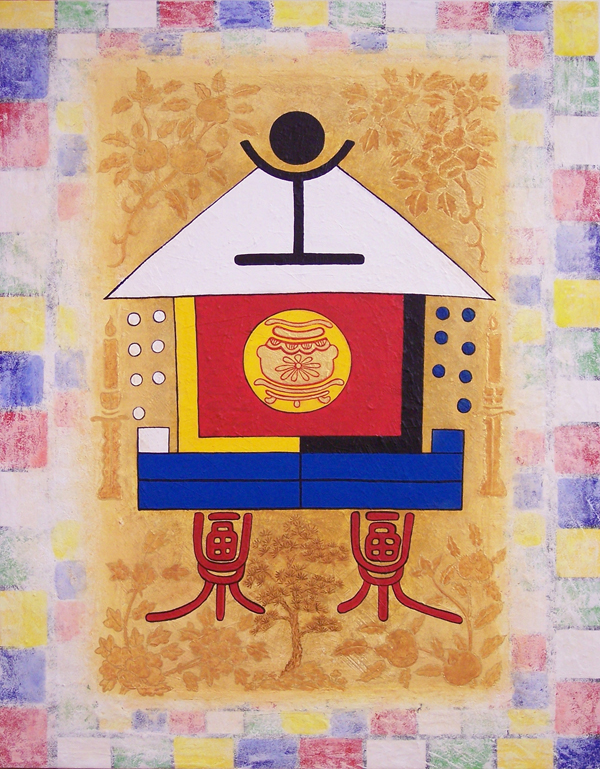
파워코리아

